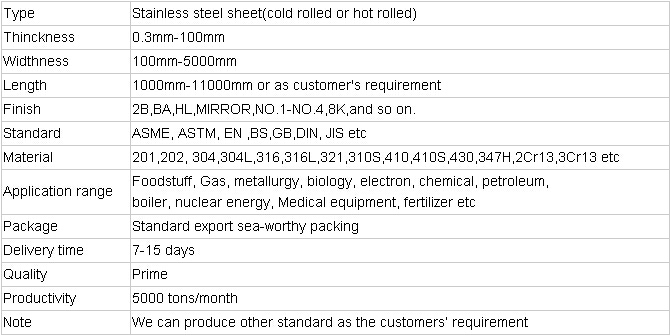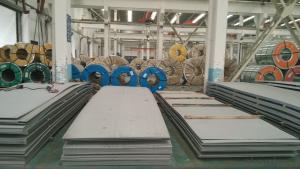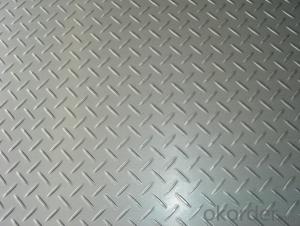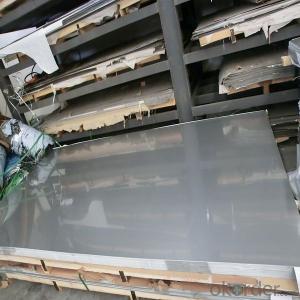Stainless Steel 304 sheet with reasonable pricing
- Loading Port:
- Shanghai
- Payment Terms:
- TT OR LC
- Min Order Qty:
- 1000 m.t
- Supply Capability:
- 1000000 m.t/month
OKorder Service Pledge
Quality Product, Order Online Tracking, Timely Delivery
OKorder Financial Service
Credit Rating, Credit Services, Credit Purchasing
You Might Also Like
Stainless steel 304 sheet
Company advantage of stainless steel:
-Top Equipments, Leading In The Industry.
- Professional Team, Leading Innovation.
- Huge Supply Capacity Advantage, Timely and Effective Delivery.
- Modern Logistic, Fact and Convenient.
- Precise Manufacturing, Exquisite Products.
- Serve People, Create Value.
- Dimensional Network, Powerful Expansion.
Product Information of stainless steel sheet:


- Q:Are stainless steel pipes suitable for high-temperature environments?
- Indeed, high-temperature environments are well-suited for stainless steel pipes. Renowned for their remarkable resistance to heat, stainless steel pipes are highly favored for applications in such conditions. They have the ability to endure a broad range of temperatures, from freezing to exceedingly high levels, all while maintaining their mechanical integrity. Consequently, stainless steel pipes prove to be the perfect choice for industries like oil and gas, chemical processing, and power generation, where elevated temperatures prevail. Furthermore, the exceptional corrosion resistance possessed by stainless steel pipes further augments their appropriateness for high-temperature settings.
- Q:Can stainless steel pipes be used for cryogenic storage tanks?
- Yes, stainless steel pipes can be used for cryogenic storage tanks. Stainless steel is known for its excellent corrosion resistance, durability, and strength, which make it suitable for storing extremely cold liquids or gases. Cryogenic storage tanks are designed to store materials at very low temperatures, typically below -150 degrees Celsius. Stainless steel pipes are capable of withstanding these low temperatures without becoming brittle or losing their mechanical properties. Additionally, stainless steel has low thermal conductivity, which helps to minimize heat transfer and maintain the desired temperature inside the storage tank. Therefore, stainless steel pipes are commonly used in cryogenic storage tanks to ensure the safe and efficient storage of cryogenic materials.
- Q:Are stainless steel pipes suitable for chemical reactors?
- Yes, stainless steel pipes are suitable for chemical reactors. Stainless steel is known for its excellent corrosion resistance properties, making it an ideal choice for handling various chemicals and acids in a reactor system. Additionally, stainless steel pipes offer high strength, durability, and heat resistance, ensuring safe and efficient operation in chemical processes.
- Q:How do stainless steel pipes compare to PVC-coated steel pipes?
- Stainless steel pipes and PVC-coated steel pipes have distinct differences in terms of material composition, durability, corrosion resistance, cost, and specific applications. Firstly, stainless steel pipes are made from a combination of iron and chromium, which provides excellent corrosion resistance and durability. This makes them suitable for applications in harsh environments, such as industrial settings or marine applications. On the other hand, PVC-coated steel pipes are made from steel coated with a layer of polyvinyl chloride (PVC). While PVC provides some level of corrosion resistance, it is not as durable as stainless steel and may degrade over time, especially in high-temperature or corrosive environments. In terms of durability, stainless steel pipes have a longer lifespan compared to PVC-coated steel pipes. Stainless steel is highly resistant to rust, corrosion, and chemical damage, ensuring long-term reliability. PVC-coated steel pipes, although corrosion-resistant to some extent, are more prone to damage from exposure to sunlight, extreme temperatures, or chemicals. When it comes to cost, PVC-coated steel pipes are generally more affordable compared to stainless steel pipes. This makes them a cost-effective option for applications that do not require high levels of durability or corrosion resistance. Stainless steel pipes, while more expensive upfront, offer a better return on investment due to their longer lifespan and reduced maintenance costs. The specific application also plays a crucial role in determining which type of pipe is most suitable. Stainless steel pipes are commonly used in industries such as oil and gas, chemical processing, food processing, and water treatment, where high strength, corrosion resistance, and hygiene are essential. PVC-coated steel pipes find application in areas such as underground drainage, irrigation systems, and electrical conduit, where cost-effectiveness and moderate durability are more important than extreme corrosion resistance. In summary, stainless steel pipes outperform PVC-coated steel pipes in terms of durability, corrosion resistance, and lifespan. However, PVC-coated steel pipes offer a more cost-effective solution for applications that do not require the same level of durability or corrosion resistance. Ultimately, the choice between these two types of pipes depends on the specific needs of the project, including its intended application, budget, and environmental conditions.
- Q:Can stainless steel pipes be insulated with asbestos?
- No, stainless steel pipes should not be insulated with asbestos. Asbestos is a hazardous material that has been linked to serious health risks, including lung cancer and mesothelioma. It is widely recognized that exposure to asbestos fibers can be extremely dangerous, and its use has been banned in many countries. There are several alternative insulation materials available that are safer and more effective than asbestos. These include fiberglass, mineral wool, and foam insulation. These materials provide excellent thermal insulation properties without posing the same health risks as asbestos. When insulating stainless steel pipes, it is important to consider the specific requirements of the application and choose an appropriate insulation material that meets the necessary safety standards. It is always advisable to consult with a professional insulation contractor or engineer to ensure the correct insulation material is selected.
- Q:Are stainless steel pipes resistant to erosion-corrosion?
- Yes, stainless steel pipes are highly resistant to erosion-corrosion due to their inherent properties such as high chromium content, which forms a protective oxide layer on the surface, preventing corrosion and erosion from occurring.
- Q:How do you calculate the expansion of stainless steel pipes?
- In order to calculate the expansion of stainless steel pipes, it is necessary to take into account the coefficient of thermal expansion (CTE) of the material. The CTE quantifies the extent to which a material expands or contracts when exposed to temperature changes. To begin, the initial length of the stainless steel pipe must be determined. This refers to the length of the pipe at the starting temperature. Subsequently, the final operating temperature of the pipe needs to be established. This denotes the temperature at which the expansion is desired to be calculated. The CTE value for the specific grade of stainless steel used in the pipe must be obtained. The CTE is typically expressed in units of per degree Celsius (or per degree Fahrenheit). Multiply the initial length of the pipe by the CTE value and then multiply it by the change in temperature. This computation yields the expansion or contraction of the pipe within the given temperature range. For instance, assume a stainless steel pipe with an initial length of 10 meters, a CTE of 17 x 10^-6 per degree Celsius, and a desired expansion calculation at a final temperature of 100 degrees Celsius. The change in temperature is determined by subtracting the initial temperature from the final temperature. Expansion = Initial Length * CTE * Change in Temperature Expansion = 10 meters * 17 x 10^-6 per degree Celsius * 100 degrees Celsius Expansion = 0.0017 meters or 1.7 millimeters Consequently, when subjected to a temperature increase of 100 degrees Celsius, the stainless steel pipe would expand by 1.7 millimeters. It is important to note that this calculation assumes a uniform expansion throughout the entire length of the pipe. In reality, thermal expansion may vary due to factors such as pipe diameter, wall thickness, and other structural considerations. Thus, it is advisable to consult industry standards or engineering references for more precise calculations in specific applications.
- Q:What's the difference between cold drawn steel tube and hot rolled steel tube?
- Hot rolling is relative to cold rolling, cold rolling is performed under recrystallization temperature, while hot rolling is rolling above recrystallization temperature.Seamless steel pipe, hot-rolled and cold-rolled (DIAL) seamless steel pipe two categories.Hot rolled steel tubes are divided into ordinary steel tubes, low and medium pressure boiler tubes, high pressure boiler tubes, alloy steel pipes, stainless steel pipes, oil cracking pipes, geological steel pipes and other steel pipes, etc..
- Q:Can stainless steel pipes be used for geothermal applications?
- Yes, stainless steel pipes can be used for geothermal applications. Stainless steel is a durable and corrosion-resistant material that can withstand the harsh conditions and high temperatures associated with geothermal systems. It is particularly suitable for geothermal applications due to its resistance to corrosion caused by the presence of minerals and chemicals in the geothermal fluid. Stainless steel pipes also have excellent heat transfer properties, which is essential for efficient heat exchange in geothermal systems. Additionally, stainless steel pipes have a long lifespan and require minimal maintenance, making them a reliable choice for geothermal applications.
- Q:What is the difference between 17-4 and 15-5 stainless steel pipes?
- The main difference between 17-4 and 15-5 stainless steel pipes lies in their composition and properties. 17-4 stainless steel is a precipitation-hardening alloy that contains around 17% chromium and 4% nickel. It also includes significant amounts of copper, niobium, and tantalum, which contribute to its high strength and corrosion resistance. 17-4 stainless steel pipes are known for their excellent mechanical properties, making them ideal for applications that require high strength and toughness. They are commonly used in industries such as aerospace, defense, and oil and gas. On the other hand, 15-5 stainless steel is also a precipitation-hardening alloy, but it contains around 15% chromium and 5% nickel. It has a higher copper content compared to 17-4 stainless steel. The addition of copper in 15-5 stainless steel enhances its resistance to corrosion and improves its toughness. These pipes are often used in applications where a combination of strength, corrosion resistance, and good formability is required. They find applications in industries such as marine, chemical processing, and food processing. In summary, while both 17-4 and 15-5 stainless steel pipes are precipitation-hardening alloys, the difference lies in their chromium, nickel, and copper content. 17-4 stainless steel offers higher strength and toughness, making it suitable for demanding applications. 15-5 stainless steel, with its increased copper content, provides enhanced corrosion resistance and formability, making it a preferred choice for certain industries.
1. Manufacturer Overview |
|
|---|---|
| Location | |
| Year Established | |
| Annual Output Value | |
| Main Markets | |
| Company Certifications | |
2. Manufacturer Certificates |
|
|---|---|
| a) Certification Name | |
| Range | |
| Reference | |
| Validity Period | |
3. Manufacturer Capability |
|
|---|---|
| a)Trade Capacity | |
| Nearest Port | |
| Export Percentage | |
| No.of Employees in Trade Department | |
| Language Spoken: | |
| b)Factory Information | |
| Factory Size: | |
| No. of Production Lines | |
| Contract Manufacturing | |
| Product Price Range | |
Send your message to us
Stainless Steel 304 sheet with reasonable pricing
- Loading Port:
- Shanghai
- Payment Terms:
- TT OR LC
- Min Order Qty:
- 1000 m.t
- Supply Capability:
- 1000000 m.t/month
OKorder Service Pledge
Quality Product, Order Online Tracking, Timely Delivery
OKorder Financial Service
Credit Rating, Credit Services, Credit Purchasing
Similar products
New products
Hot products
Hot Searches
Related keywords
































